

Tracing
My Roots in Rakishok
By
Sorrel Kerbel, D.Phil.
Editors’
Note
(Philip Shapiro): Dr.Sorrel Kerbel’s
great-grandfather, Rabbi Bezalel Shlomo Ha-Cohen Katz
(1843-1939), was a
prominent Hasidic rabbi in Rokiskis and the story of his family
provides a
glimpse of Jewish life in that shtetl from the 19th
Century until
its destruction in 1941. This article first appeared in two
instalments in Shemot,
the journal of the JGS of Great Britain, March 2003,
vol. 1.1, and
June 2003, vol.II.2.
Dr.Kerbel
is
the editor of the Routledge Encyclopedia of Jewish Writers
of the
Twentieth Century, 2003 and 2010, a reference work
providing essays on the
“Jewishness” or not of some 350 Jewish novelists, poets and
dramatists all
around the world. She received a D.Phil. in English literature
from the
University of Cape Town. She taught English literature at the
University of
Port Elizabeth, where she and husband Jack lived for 24 years
before emigrating
to London. They, their three children, and eight grandchildren
live in the UK,
where she is an independent researcher and reviewer. She
has also worked
for some years in London with Holocaust survivors through Jewish
Care.
The
original
version of Dr.Kerbel’s article, “Tracing My Roots in Rakishok”
was published on the Rokiskis Kehilalinks website.
For
this publication, she has updated her article. Dr.Kerbel
holds the
copyright to this story, which may not be used without her
permission.
Author’s
Introduction
to the Updated Article. As a result of the publicity
generated by the publication of my article in 2003, I discovered
a very special
relation in Cape Town, Attie Katz. This updated version is
dedicated to
him and to the honoured memory of all of my family who perished
at the hands of
a few Nazis and their willing Lithuanian collaborators in the
Lithuanian Shoah.
A new exhibition currently on show (2017) in Berlin about Litvak
Jews for the
first time acknowledges German responsibility for the “deaths by
bullet” in
Lithuania.
I
would like to use here a quotation from Roger Cohen’s essay, The
Girl From
Human Street, which was dedicated to his mother (New
York Times,
April 1, 2016). “Every Jew of the second half of the 20th
century
was a child of the Holocaust. So was all humanity. Survival
could only be a
source of guilt, whether spoken or unspoken. We bore the imprint
of departed
souls … I wanted to understand where I came from.” This
article, “Tracing
My Roots in Rakishok,” reflects my personal quest to
understand where I
came from and to remember so many names from the silenced past.
I
am grateful to many for helping me update this article,
including, but by no
means limited to, my husband Jack, my children and
grandchildren,
Shemot,
JewishGen’s Yizkor Book Project, Philip and Aldona Shapiro in
the USA, Giedrius
Kujelis of the Rokiskis Regional Museum, and my many friends and
family who
helped me organize genealogical details, namely (in alphabetical
order), Cookie
Epstein, Ada Gamsu, Dorothy Gelcer, Julia Segal-Holzer, Gerry
Hornreich, Anne
Martin, Ros Romem, Paul Teicher, the Todres brothers and my
Windisch family.
One of our most amazing new links is to my favourite Yiddish
playwright and
novelist, Sholem Aleichem, and his daughter Bella.
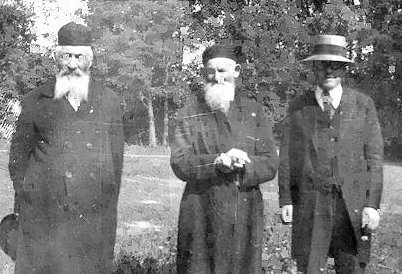
Reb Bezalel Shlomo
Ha-Cohen Katz (centre) with his son-in-law, Reb Avrom Meirowitz
(left), and Reb
Bezalel’s nephew, Rabbi Shmuel Yalowetsky. The photograph
was taken in Rakishok
on the eve of Rabbi Yalowetsky’s departure for the USA, where he
would be known
as Rabbi Samuel Yalow of Syracuse, New York. The two
younger rabbis
received smicha from Reb Bezalel. Rabbi Yalow is
wearing a new
straw hat to show off his role as a soon-to-be American.
Part
1
My mother’s
grandfather, Reb Bezalel Katz, “cheated” the Nazis by dying in
July 1939, three
months before the start of World War II. Reb Bezalel lived to
the grand old age
of 96. His 93-year-old wife Chaya Sora (nee Yalowetsky), for
whom I am named,
followed him a few weeks later to a peaceful grave. (She was
affectionately
known as Rebbitzen “Sorke.”) But the family was not
able to erect
gravestones to their memory, as my mother, Nechama
Meirowitz-Stein, explains in
her essay in the Rakishok Yizkor book, “A Few Words in
Place of a
Tombstone.”1

This is the only
known
surviving image of Rebbetzin Sorke, the wife of Reb
Bezalel Katz, for
whom I am named. She is shown here with her grandson,
Israel Meirowitz,
on the enclosed porch of their house, which stood facing the
market square of Rakishok.
Rakishok, which is 13 miles
from the Latvian border, was
the largest shtetl in the northeastern region of Lithuania and
was the district
capital after 1915. It was a flourishing spiritual and
business centre
for Lithuanian Jewry. The Jewish population fluctuated in number
according to
the exigencies of the times. In 1847, the Jewish population was
593; in 1897,
it was 2,067, constituting 75% of the general population; in
1914, on the eve
of the First World War, it was about 3,000, out of a general
population of 3,829.
In 1923, following the upheavals of the First World War,
2,013 Jews lived
there, constituting about half of the general population. In
1939, there were
3,500 Jews, constituting about 40% of the general population.2
Rakishok had excellent rail
connections to Dvinsk,
Riga, Panevezys (Ponovezh), Siauliai (Shavli), and
Kaunas (Kovno)
which facilitated trade. What contributed to its special
development and
stability were its long-standing and well-established markets
for many kinds of
products, such as flax, seeds, furs, grain, eggs, butter, fruit,
poultry,
lumber, and meat. During this era, there was also intensive
trade by Rakishker
Jewish merchants in raw hides and skins. Most Jews were traders
and peddlers,
but there were also artisans, such as tailors, shoemakers,
hat-makers,
butchers, bakers, metalworkers, and clockmakers. Several hundred
Jews worked in
small Jewish-owned industries like the tannery, flour mills,
sausage factory,
casting factory, and electric station. Most of the town’s
doctors and pharmacists
were Jewish.3
Rakishok developed from an
estate owned by the Polish
house of Kroshinsky. The widowed Princess Helena, the last of
that family,
married Count Tizenhoff, and Rakishok passed to the
family of the Counts Pshezdetsky. The impressive St. Matthew’s Catholic
Church, which overlooks the market square, was built between 1866 and 1885
upon the initiative of Count
Reynold Tizenhoff. It is positioned to have a clear view
beyond the
market square to the front of the Tizenhoff manor house, one
kilometer to the
east. Then, as now, its towering spire dominates the
landscape.
Reb Bezalel
(1843-1939)4 was born in Rakishok and lived
“for as long as
anyone could remember” on the Kamayer Gasse (now,
Respublikos
gatvė). This street originally led directly south from the
market square
to Kamai, which is 11 miles away. Across from Kamayer
Gasse
the market place would particularly bustle on Mondays, which
were market days,
on Sundays, when churchgoers would patronage Jewish shops, and
especially on
fair days, when thousands of peasants would come to town. Near
his Kamayer
Gasse house were the Batei Midrashim (houses of
study) on Synagogue
Street (now, Sinagogų gatvė). From the time that Lithuania
became an
independent country, the synagogues were painted, respectively,
the colours of
the Independent Lithuanian flag – the yellow one was for
scholars, the green
one was for community leaders, and the red one, which was the
largest, was for
the general community. Prior to the First World War, there
was a fourth
synagogue nearby on Pirties gatvė (Bath Street) that had been
built for use by mitnagdim.
That synagogue had its own mikveh (ritual bath).
During the First
World War, the mitnagid synagogue was destroyed by a
fire. Of the
many Jews who fled either to Russia or Germany during the war,
the relatively
few mitnagdim who returned to Rakishok could not
afford to
rebuild their synagogue. As a result, it was agreed that
the great
(“red”) synagogue would be used by everyone in the community.
Near this area were
other buildings that were important for business, such as most
of the larger
shops for textiles and leather goods, flour storehouses,
warehouses, a bank,
and even a showroom of Singer’s Sewing Machine Company.5
The
bank, which was known as the Rakishker Yudishe Folkbank (in
Lithuanian,
“Rokiškio Žydų Liaudies Bankas”) was the Rakishok branch
of the Folkbank.
The Folkbank was established after the First World War
with assistance
from the Joint Distribution Committee (“Joint”), an American aid
organization,
and had several branches in Lithuania. (There were also branches
in six Balkan
countries).
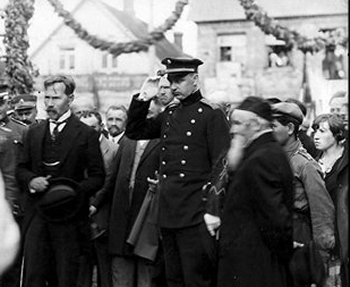
Reb Bezalel was the
“official” rabbi of Rakishok, and met the first
President of Independent
Lithuania, Antanas Smetona6, on his visit to Rakishok
on the
occasion of the opening of the new railway station, circa 1920.
He stood, a
frail figure, on the festooned podium with the president and
Graf
Tizenhoff. Later that day; the President visited the
synagogue complex.
My great-grandfather Bezalel was a Hasid who gathered
around him other
rabbis of his persuasion, each with their own followings -
Lubavicher,
Babroisker, and Ladier. My mother describes her
grandfather as a
figure of great piety, modesty, and tolerance, who studied “Yom
ve’laila”
(day and night). He wrote many books and articles which
regrettably have gone
missing. He was also something of an expert in Hebrew, and once
wrote a much
praised letter in Hebrew to the director of education at the Rakishok
pro-gymnasium
(high school) which used Hebrew as the medium of
instruction.
This was the school where my mother and her sisters were
educated. Reb
Bezalel’s granddaughter Feiga married Josef Caspi who served as
the principal
of both the Tarbut Bet Sefer and Pro-Gymnasium.7


In the photo on left:
My mother Nechama (centre), with her sister Liebe-Leike
(Leah) far left
(with fringe). Photo on right: Joseph Caspi (centre)
with a
pro-gymnasium class. To the right of Caspi is my mother
Nechama and to
the right of her is her sister Liebe-Leike. In
the second row on the
left, wearing a white collar, is Julia Segal Holzer.
The Graf Tizenhoff
greatly admired my great-grandfather, who initially worked for
him as an
ironmonger and was for a short while his agent on the
estate. In 1931,
when the Lubavicher Rebbe Yosef Yitzchak Shneersohn
honoured Reb Bezalel
with a visit, Reb Bezalel met him at the railway station with a
carriage and
horses loaned by Graf Tizenhoff, and they drove through the town
to the
synagogue behind his house on Kamayer Street.
According to an
anecdote told by aunt Rochel Kalwaria, a non-Jewish neighbour
who was present
proudly told my great-grandmother, Rebbitzen Sorke,
“your Kaiser has
arrived.”
After working for the
Baron, Reb Bezalel received smicha (becoming ordained as
a rabbi) from
his father, Reb Yosef Ha-Kohen Katz, who was then the rabbi of Rakishok.
Reb
Bezalel served as a rabbi in Karsevke, (now, Kārsava,
Latvia, which
is about 82 miles northeast of Dvinsk (now, Daugavpils),
Latvia), where he had
a “guten nomen” (good name/standing). (This is a
reference to Pirkei
Avot (Ethics of Our Fathers) 4:13, in which it is
said that “there are
three crowns: the crown of Torah, the crown of priesthood, and
the crown of
kingship. However, superior to all of these is the crown of a
good
name.”) For his second rabbinic post he returned to Rakishok,
inheriting the rabbinic “kisei” (seat) of his father, Rabbi
Yosef HaKohen Katz.
My great-grandfather,
Rabbi Bezalel, and his wife Sara had a daughter and three
sons. Their
daughter, Asne Rifke (1876-1941), married my grandfather, Rabbi
Avrom (Abraham)
Meirowitz (1875-1941), who is discussed below.
Reb Bezalel himself
came from an important family. His father, Reb Yosef
Ha-Kohen Katz, was
born around 1828 in Rakishok and had six sons, some of
whose descendants
managed to escape to South Africa, Israel, Australia, and the
USA. Avrom
Leib, the eldest, was the great-grandfather of Dov Katz of
Pardes Hanna
(Karkur), Israel, Attie and Sheilah Katz of
Cape Town, and Ann
Martin of Johannesburg. Bezalel, the second son and my
great-grandfather, was
also the great-grandfather of Thelma Windisch of London, Aharon
Barak and Avi
Kalir of Tel Aviv, and Riki Hirsowitz of Sydney, Australia. The
descendants of
Berzik, the third son, established the jewellery store Katz
& Lurie in
Johannesburg. The descendants of Shmuel, the fourth son,
perished in
Lithuania. The fifth son, Yaakov Katz (b. 1879 in Rakishok),
married
Reisa Galbershtat of Rakishok (1879-1939). Their
son,
Chaim Tuvia Katz (1909-1990), was a founding member of Dafna (3
May 1949), a
kibbutz in the Upper Galilee of Israel. He and his wife Chaya
Shein Czarka had
two children, Tsofar Katz and Avigail, who live in Haifa.
The sixth son,
Shnuer Zalman (Shneyer Zalman) (b. 1881), died in Abel in
1941. Reb Yosef
also had two daughters, one of whom, Raisa Devorah, married Reb
Zecharya Alter
Abrahams (whom my mother called called “Avromtzik
Jossel”). Their son was
Chief Rabbi Prof. Israel Abrahams of Cape Town, who was the
father of Ros Romem
of Jerusalem.
Reb Yosef, too, came
from an illustrious family. He was the second of five sons born
to Reb
Meir Ha-Kohen Katz, who was born in Linkuva around
1795. Reb Meir
was serving as a rabbi in Rakishok when his second son,
Yosef, was born
there. Thus, the Katz family served as rabbis in
Rakishok for at
least a hundred years. According to family legend,
generations of Ha-Kohen
Katz rabbis served in communities in Lithuania for more than 300
years. The
five sons of Reb Meir Ha-Kohen Katz are a genealogist’s
nightmare because they
were each given different surnames at birth to avoid 25 years’
conscription
into the Czar’s army. The eldest was Shmuel Leib Ha-Kohen Kaplan
(b. 1808 in Rakishok,
whose descendant Valerie Mathieson from the USA provided
details of Shmuel
and his wife Taube Kuperman of Rakishok and their six
children, all of
whom died in Lithuania); the second son (my
great-great-grandfather) was Yosef
Ha-Kohen Katz; the third son’s name was not known to my mother,
though she
notes that he later became a rabbi in Linkuva, taking his
father’s place
(this may be the Rabbi Aharon Ha-Cohen who is mentioned on the
Linkuva Kehilla
website as having endorsed the collection of funds to assist
distressed Jews
after a large fire burned about 100 buildings, including the
community’s wooden
synagogue); the fourth son was the eminent science populariser,
Tzvi Hirsch
Ha-Kohen Rabinowitz (1832-1889); and the youngest son of Reb
Meir was called
Moshe Yaffe. (My mother notes simply that he was “a merchant,”
and therefore
did not have much “koved” (prestige) in her eyes.)
The fourth son of Reb
Meir Ha-Kohen Katz, Tzvi Hirsch Rabinowitz, showed an early
inclination for
mathematics and physics. From 1852, while studying in St.
Petersburg, he began
work on a comprehensive Hebrew-language project that was
intended to encompass
all the fields of physics. At length, one volume was
published, in 1867,
which was entitled, Sefer ha-Menuchah ve-ha-Tnuah (“The
Book of Rest and
Movement”).
Tzvi Hirsch also
wrote
Hebrew-language books on mathematics, magnetism, chemistry, and
steam-engines,
thus enriching Hebrew terminology in these fields and bringing
them to the
attention of Hebrew readers. He also published many articles in
Ha-Meliz
(“The Ornamentation”) and in several Russian periodicals which
he edited and
published, including Russki Yevrei (Russian Jews) from
the late 1870s
until 1885. All of his books were published in Vilna/Vilnius.

Title Page of Tzvi
Hirsch Meir HaCohen Rabinowitz’s “Yisodei HaChachmat HaTeva
HaKlalit,”
Vilna (1867).
As noted above, my great-grandparents, Rabbi
Bezalel and Rebbitzin Sorke Katz, had a daughter Asne
Rifke (1876-1941),
who married my grandfather, Rabbi Avrom (Abraham) Meirowitz
(1875-1941).
Avrom Meirowitz was the fourth child of Moshe and Rifke
Meirowitz of Karelitz
(Karelichi), a town 15 miles east of Novogrudek that was
in the province
of Minsk. Moshe and Rifke had 6 children, namely, Berl
David, the eldest,
whose family settled in Rhodesia and Israel; the second son
Yaakov, who
emigrated to the U.S., where there are many cousins; Ethel
Cohen, who died in
1941; my grandfather Avrom; Yudel, who died in 1941; and the
youngest, Meir,
whom, they said, was killed by the Cossacks. Meir’s wife
Machle (nee
Sachar) was from Kupishok and her brother, A. L. Sachar,
was the
founding president of Brandeis University. Her children
settled in
Israel.
Avrom Meirowitz
studied at the yeshivas of Mir, Slobodka, and Volozhin (where
his
study-partner at one time was the renowned Hebrew poet, Chaim
Nachman Bialik).
When my mother, Nechama Meirowitz-Stein, was born in Rakishok,
the
couple lived in her grandfather’s home because her father served
in the nearby
shtetl Skimiahn (Skemai, which is about 6 miles
northeast of Rakishok).
In early May 1915,
during the First World War, the Czarist government ordered the
Jews of central
Lithuania exiled to the interior of Russia – on two days’
notice.
Although the order did not apply to Jews in northeastern
Lithuania, many were
concerned about the approach of the war front. The family,
together with
most of the Jewish inhabitants of Rakishok, fled into
Russia for safety.
Unfortunately, Russia experienced two revolutions in 1917,
followed by a civil
war. It was only after (Soviet) Russia and the new
independent Lithuanian
republic reached a peace agreement that the Jewish exiles could
return to
Lithuania. My mother recalls that as a child of ten, when her
family returned
to Rakishok, they were welcomed back by the Lithuanian
townspeople with
“flowers, love, and honour.”
My mother Nechama
wrote in the Yizkor book that her father, Rabbi Avrom
Meirowitz, was a
wise man who was no stranger to world affairs despite having
lived in a
relative backwater. He was a mitnagid who read many
secular books. His
command of Russian and German, acquired on his own, led him to
read the great
literature of those languages, including the works of Dostoevsky
and
Tolstoy. My grandfather’s horizons went well beyond the
confines of the
narrow world of the shtetl. He was a founding member of the Rakishok
branch
of the Folkbank and served as the bank’s director in Rakishok.
In
addition, he went often to Ponovezh (Panevėžys),
where he sat on
a rabbinical arbitration board to resolve disputes among
litigants.
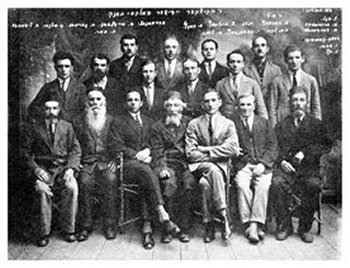
Rabbi Avrom Meirowitz
was the chairman of the Folkbank. He is shown
here, in the centre
of the front row, with other members of the management board.
First row,
sitting right to left: Shloime Arelovits, Hillel Eidelson, Abba
Leib
Dovidovits, Avrom Meyerowitz, Leib Segal, Zalman Milner,
Israel-Leib Snieg;
Second row, right to left: Isaac Panets, Chaim-Moteh Lekach,
Avrom Harmets,
Yudel Gafanovits, Hertze Lang, Yosef Caspi; Third row, right to
left: Velvel
Lipovits, Mr. Bar, Nahum Katz, Solomon German.
The marriage of my
grandfather, the mitnagid Rabbi Avrom, to my grandmother
Asne, the
daughter of the hasidic Rabbi Bezalel, reflects a good
deal of tolerance
on the part of the latter, who even permitted the young
married couple to
live in his household.
By the middle of the
1920s, with anti-Semitism growing in Lithuania, many Jews began
to consider
emigrating, especially to Palestine. The Balfour
Declaration had promised
the establishment there of a Jewish homeland. My grandfather,
Rabbi Avrom
Meirowitz, had a strong Zionist orientation (perhaps acquired at
Volozhin
Yeshiva, which was known for its espousal of Zionism).
This inclination
led him to join the Mizrachi - the National Religious
Party - within the
Zionist movement, and he appeared as a speaker at their meetings
and rallies.
As a result, understandably, he was less popular among the
ultra-orthodox Agudas
Yisroel circles.
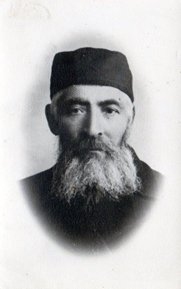
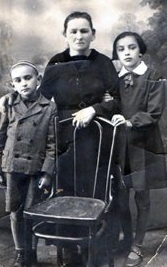
Left photo: My
grandfather, Reb Avrom Meirowitz, the last rabbi of Abel.
Right
photo: My grandmother, Asne Rifke Meirowitz, with her two
grandchildren,
Josef and Ester Michelson, the children of her eldest daughter
Taube Mirkes.
All were murdered in Abel in 1941.
In 1928 my
grandfather
became the rabbi in Abel (Obeliai), nine miles to the
east. At a
rabbinical conference in Ponevezh in the late 1930s, he
warned his
audience of the imminent dangers of Nazism, saying they were
mistaken in
thinking Hitler’s objectives were confined to the destruction of
only German
Jews. This raised much criticism among the Agudah
delegates, and his
admonition fell on deaf ears.
Although Reb Avrom
possessed immigration papers for America, his wife, Asne Rifke,
refused to
leave Lithuania without her grandchildren. Sadly, he met his
death from an axe
wielded by a Lithuanian collaborator while standing on the
bima of the
shul in Abel, where all of the Jews of the village
were held in
August 1941. He was thus the last rabbi in Abel. Because
of my mother’s
delicate health, the truth of his death was kept from her, and
the sanitized
version she gives in her essay is not correct, according to my
mother’s last
surviving sister, Rochel (Rachel) Kalwaria of Kiryat Ono, Israel
(July 1995).
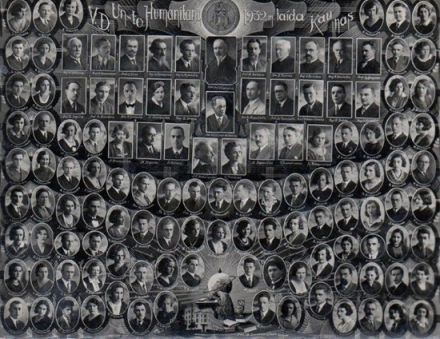
In this photograph of
the 1932 graduates from Vytautas Magnus University, my mother,
Nechama
Meirowitz, is shown on the next-to-bottom row, on the far
left. Immediately
to the right is her sister, Liebe-Leike Meirowitz.
Poor as they
were, the Meirowitz family was enlightened and determined enough
to send their
children to college. My mother Nechama received a B.A.
degree from
Vytautus Magnus University in 1932. Her two sisters,
Liebe-Leike and
Rachel, became, respectively, a teacher and a pharmacist, while
their brother
Yisroel (Israel) became a medical doctor. They would go off by
train from the
nearby Rakishok railway station to the University in
Kaunas where they
boarded with Rakishker landsleit. My mother told me how,
in winter,
their landlady would be sent a frozen barrel of veal or beef by
train, as
partial payment for their board. (Rakishok was an
important centre for
the wholesale meat trade.)
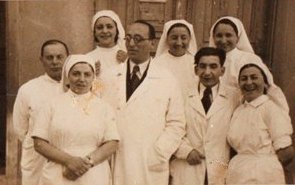
Photo of my mother’s
brother, Dr. Israel Meirowitz (front row, second from the
right), with
colleagues at a hospital in Kaunas. In 1944, while out on
a medical call,
he was shot dead.
In Lithuania, my
mother’s family and friends gave her the nickname “die
shvartze varona” (“the
black crow/raven”) because she forewarned of a dismal future for
Jews in
Lithuania and tried to convince them to emigrate. After her
graduation from
Vytautas Magnus University she left for Jerusalem, where she
married my father,
Nathan Stein, and then migrated once more (with my sister
Thelma) to Cape Town,
South Africa.
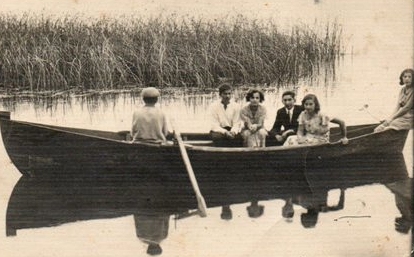
A boating party
in
peaceful times on Lake Obeliai. Fourth from the right is
Julia Segal
Holzer, my mother’s friend who was also saved in the maline
in the Kovno
ghetto. Third from the right is my mother’s brother, Dr. Israel
Meirowitz. Second from the right may have been Israel’s
fiancé, Miriam
Jaffe, from Kupishok.
Footnotes
1 Nechama
Meirowitz-Stein, “A Few Words
in Place of a Tombstone” in Yizkor-Book of Rakishok and
Environs, edited
by M. Bakalczuk-Felin, Johannesburg, Yizkor Book Publishing
Council, 1952, pp.
145-149. Most of the family information here was learned at my
mother’s knee or
contained in her essay. I am indebted also to Alan Todres of
Chicago and
Raymond Karpelofsky of London who helped me with the Yiddish
translation.
2 Nancy
Schoenberg and Stuart Schoenberg,
Lithuanian Jewish Communities, New York, Garland
Publishing, 1991, pp.
240-244.
3 R. Aarons
-Arsch, “Notes on the Economic Position of the
Jews in Rakishok.”
in Yizkor-Book of Rakishok and Environs, pp. 19-29.
4 The All-Russia
Census of 1897 gives
ages for Reb Bezalel and various members of the family which do
not coincide
with the ages presented here. For the purposes of this article,
I have chosen
to use the ages recorded by my mother in the Yizkor-Book of
Rakishok and
Environs.
5
A. Orelowitz, “Rakishok Before and After World War
I”
in Yizkor-Book
of Rakishok and Environs, pp. 7-18.
6 Antanas
Smetona (1874-1944) was the
president of Lithuania from April 1919 to June 1920 and then
from late 1926
until the end of the first Lithuanian republic. During
most of the latter
period, he ruled as an autocrat. Ostensibly and officially a
“friend of the
Jews,” he surprised the British Consul in Kaunas by describing
the Jews of
Lithuania as “active Communists” and “dishonest traders.” Masha
Greenbaum,
The Jews of Lithuania: A History of a Remarkable Community
1316-1945, Jerusalem, Gefen Publishing, 1995, p. 279. On June 15, 1940, as the
republic succumbed
to Soviet annexation, Smetona fled to Germany, and a year later
moved to the
USA.
7 Feiga, my mother’s
cousin and the daughter of
Aharon Katz, married Josef Caspi (Serebrovitz), who wrote as a
Jewish
journalist using the name “Caspi.” He was born in Rakishok,
worked first
at the Folkbank (employed by Rabbi Avrom Meirowitz),
then as principal
of the Tarbut School and Pro-gymnasium in Rakishok.
Because of his
capitalist views, he was imprisoned in 1940 during the initial
Soviet rule and
released shortly after German occupation in late June 1941. He
then threw in
his lot with the Germans so that he could fight communism. He
was exempted from
wearing the yellow Star of David and allowed to live in Kaunas
outside the
ghetto and even to carry a gun. He was, in his own mind, “a
living legend who
will go down in Jewish history” (his words to the Council in the
Kovno
ghetto). He acted as an intermediary between the ghetto council
and the Nazi
commandant. In October 1941, he was sent to Vilnius. In June
1943, back in
Kaunas, he was shot by the Nazis together with his wife and two
daughters.
Shortly before his death Caspi addressed the Jewish council of
the Kovno
ghetto, “You entertain illusions of survival. I know that if I
survive, it will
only be by chance.” (He is shown in the photo above of the
pro-gymnasium class
with my mother and her sister Leibe. An account of this
story appears in
Avraham Tory’s Surviving the Holocaust: The Kovno Ghetto
Diary,
Cambridge, Massachusetts, and London, Harvard University Press,
1990.
Click here to continue reading Part 2 of this fascinating story.
Return to
Main Page